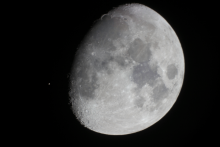Listen to today's episode of StarDate on the web the same day it airs in high-quality streaming audio without any extra ads or announcements. Choose a $8 one-month pass, or listen every day for a year for just $30.
You are here
Moon and Aldebaran
You can’t tell it just by looking, but our solar system is orbiting the center of the Milky Way galaxy at about half a million miles per hour. And the stars around us are moving at similar speeds. In fact, one of the first stars to have its motion measured stands quite close to the Moon tonight.
Aldebaran is the leading light of Taurus, the bull. It’s just an eyelash away from the Moon as they climb into view around midnight, and even closer to the Moon at first light. In fact, as seen from parts of the western United States, the Moon will pass in front of Aldebaran, blocking its light — an event known as an occultation.
Three centuries ago, Edmond Halley studied an occultation of Aldebaran that happened in the year 509. And he got a surprise: He found that, over the centuries, Aldebaran had shifted position relative to the other stars. Studies of two other stars showed that they, too, had moved.
That change in a star’s position is known as proper motion. It’s caused by a combination of motions — ours, and the other star’s.
Aldebaran is fairly close — just 65 light-years away — so its motion is more pronounced than that of many other visible stars, which are farther away. Since the occultation of 509, in fact, Aldebaran has moved roughly a quarter the diameter of the Moon in our sky. It’s a tiny shift. But it adds up. Over the millennia, Aldebaran will drift slowly southward — depriving the bull of his bright eye.
Script by Damond Benningfield



